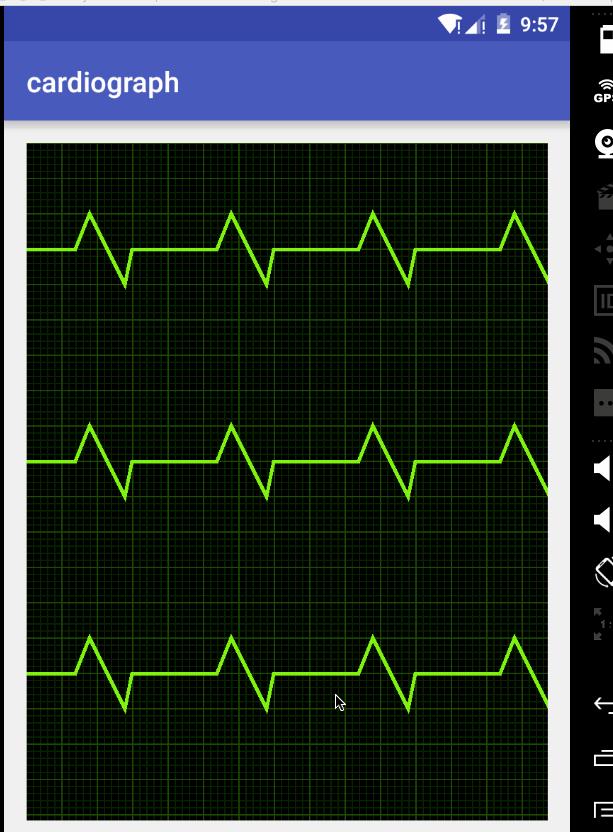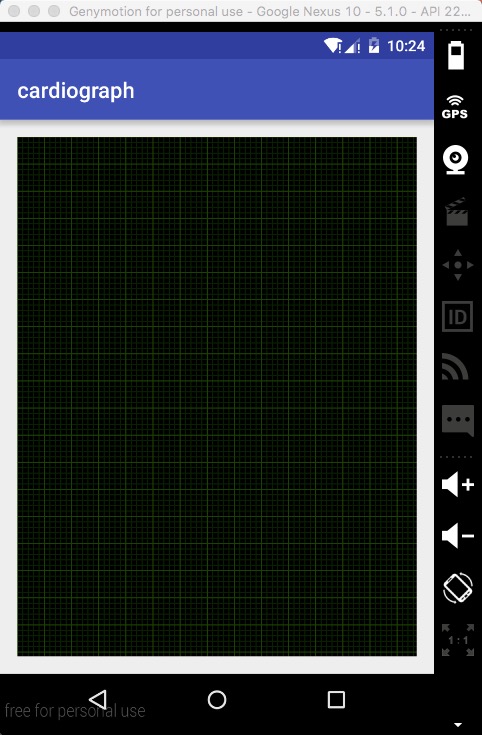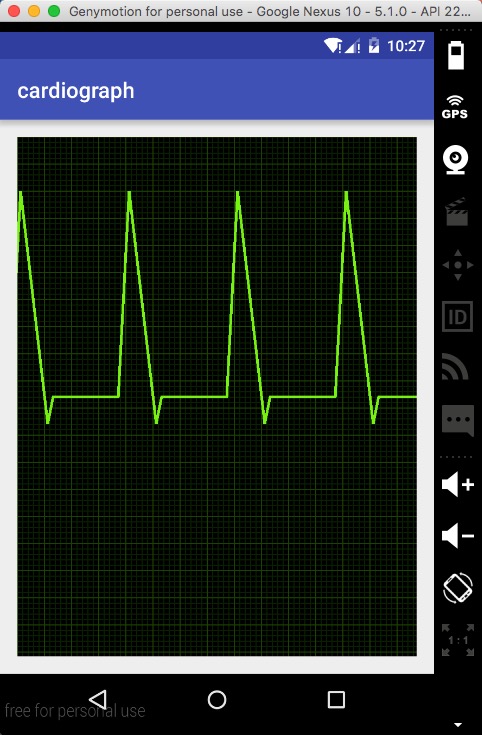手把手教你打造一个心电图效果View Android自定义View
Posted 三精-大精wing
tags:
篇首语:本文由小常识网(cha138.com)小编为大家整理,主要介绍了手把手教你打造一个心电图效果View Android自定义View相关的知识,希望对你有一定的参考价值。
大家好,看我像不像蘑菇…因为我在学校呆的发霉了。
思而不学则殆
丽丽说得对,我有奇怪的疑问,大都是思而不学造成的,在我书读不够的情况下想太多,大多等于白想 ,所以革命没成功,同志仍需努力。
,所以革命没成功,同志仍需努力。
好了废话不说了,由于布总要做一个心电图的玩意,所以做来练练手,总之拿到的UI图如下:

做好的效果如下:

拿到图,先做一些简单的分析。呃..
- 背景表格的绘制
- 心电图的绘制
背景表格的绘制:
首先drawColor黑色,然后用循环来画线、
心电图的绘制:
看样子是path,应该没问题。
于是就大干一番,按照这俩步骤画完了。。结果发现,嗯。。确实画上去了,关键怎么让他动呢。。 轻而易举想到scrollBy吧。然后你就发现。。背景也跟着变了。。 遇到问题就要解决。。所以这里投机取巧一下 把两个View分离,即背景是一个View,折线图是一个View。
首先,创建一个View,用来做背景View。他有一些属性,因为这些View本来是一个,后来又有一个折现View需要相同的属性,所以索性偷懒改成protected修饰。。
转载请注明出处:http://blog.csdn.net/wingichoy/article/details/51023865
public class CardiographView extends View {
//画笔
protected Paint mPaint;
//折现的颜色
protected int mLineColor = Color.parseColor("#76f112");
//网格颜色
protected int mGridColor = Color.parseColor("#1b4200");
//小网格颜色
protected int mSGridColor = Color.parseColor("#092100");
//背景颜色
protected int mBackgroundColor = Color.BLACK;
//自身的大小
protected int mWidth,mHeight;
//网格宽度
protected int mGridWidth = 50;
//小网格的宽度
protected int mSGridWidth = 10;
//心电图折现
protected Path mPath ;定义了这些属性,在构造器里初始化一下画笔和Path
public CardiographView(Context context) {
this(context,null);
}
public CardiographView(Context context, AttributeSet attrs) {
this(context, attrs,0);
}
public CardiographView(Context context, AttributeSet attrs, int defStyleAttr) {
super(context, attrs, defStyleAttr);
mPaint = new Paint();
mPath = new Path();
}接下来拿到自身的宽高。注意为了简化例子,这里就不测量了
@Override
protected void onSizeChanged(int w, int h, int oldw, int oldh) {
mWidth = w;
mHeight = h;
super.onSizeChanged(w, h, oldw, oldh);
}准备工作都完成,开始绘制背景,创建一个drawBackground(Canvas canvas)方法。
可以想到,用for循环来画横线竖线。横线的起始x坐标都是0,终止x坐标是mWidth, y坐标为i*mGridWidth(网格宽度),我们要拿到网格的个数,即宽高除以网格宽度,具体操作看代码:
private void initBackground(Canvas canvas) {
canvas.drawColor(mBackgroundColor);
//画小网格
//竖线个数
int vSNum = mWidth /mSGridWidth;
//横线个数
int hSNum = mHeight/mSGridWidth;
mPaint.setColor(mSGridColor);
mPaint.setStrokeWidth(2);
//画竖线
for(int i = 0;i<vSNum+1;i++){
canvas.drawLine(i*mSGridWidth,0,i*mSGridWidth,mHeight,mPaint);
}
//画横线
for(int i = 0;i<hSNum+1;i++){
canvas.drawLine(0,i*mSGridWidth,mWidth,i*mSGridWidth,mPaint);
}
//竖线个数
int vNum = mWidth / mGridWidth;
//横线个数
int hNum = mHeight / mGridWidth;
mPaint.setColor(mGridColor);
mPaint.setStrokeWidth(2);
//画竖线
for(int i = 0;i<vNum+1;i++){
canvas.drawLine(i*mGridWidth,0,i*mGridWidth,mHeight,mPaint);
}
//画横线
for(int i = 0;i<hNum+1;i++){
canvas.drawLine(0,i*mGridWidth,mWidth,i*mGridWidth,mPaint);
}
}现在的运行效果是这样的:

呃。。。看起来像点样子了。。
现在给加上Path吧。。新建一个View,写到相对布局的底部
<?xml version="1.0" encoding="utf-8"?>
<RelativeLayout xmlns:android="http://schemas.android.com/apk/res/android"
xmlns:tools="http://schemas.android.com/tools"
android:layout_width="match_parent"
android:layout_height="match_parent"
android:paddingBottom="@dimen/activity_vertical_margin"
android:paddingLeft="@dimen/activity_horizontal_margin"
android:paddingRight="@dimen/activity_horizontal_margin"
android:paddingTop="@dimen/activity_vertical_margin"
tools:context="com.wingsofts.cardiograph.MainActivity">
<com.wingsofts.cardiograph.CardiographView
android:layout_width="match_parent"
android:layout_height="match_parent"></com.wingsofts.cardiograph.CardiographView>
<com.wingsofts.cardiograph.PathView
android:layout_width="match_parent"
android:layout_height="match_parent" />
</RelativeLayout>
为了简单起见,新建一个View 继承CardiographView, 这里只需要重写他的ondraw方法即可,其他属性不需要定义。
private void drawPath(Canvas canvas) {
// 重置path
mPath.reset();
//用path模拟一个心电图样式
mPath.moveTo(0,mHeight/2);
int tmp = 0;
for(int i = 0;i<10;i++) {
mPath.lineTo(tmp+20, 100);
mPath.lineTo(tmp+70, mHeight / 2 + 50);
mPath.lineTo(tmp+80, mHeight / 2);
mPath.lineTo(tmp+200, mHeight / 2);
tmp = tmp+200;
}
//设置画笔style
mPaint.setStyle(Paint.Style.STROKE);
mPaint.setColor(mLineColor);
mPaint.setStrokeWidth(5);
canvas.drawPath(mPath,mPaint);
}好了,现在画出来是这样的:

那怎么让他动起来呢。 当然是scrollBy了~~ 这里注意下scrollBy 和scrollTo的区别,面试常考的,之后再postInvalidateDelayed即可
@Override
protected void onDraw(Canvas canvas) {
drawPath(canvas);
scrollBy(1,0);
postInvalidateDelayed(10);
}大功告成! 这样就和上面的实现图一样了:

当然这只是个demo,你可以根据自己的需求去不同的坐标去绘制,来达到真实的心电图效果。
如果你喜欢我的博客,请点关注哦。。
另外:如果你有职位 只要在广州 欢迎拉我,我刚辞实习工作,六月就要毕业了,即将失业了!!!
本项目地址(求star):点击打开
以上是关于手把手教你打造一个心电图效果View Android自定义View的主要内容,如果未能解决你的问题,请参考以下文章
个推数据智能技术实践 | 教你打造数据质量心电图,智能检测数据“心跳”异常
个推数据智能技术实践 | 教你打造数据质量心电图,智能检测数据“心跳”异常
# yyds干货盘点 # 手把手教你使用JavaScript打造一款扫雷游戏